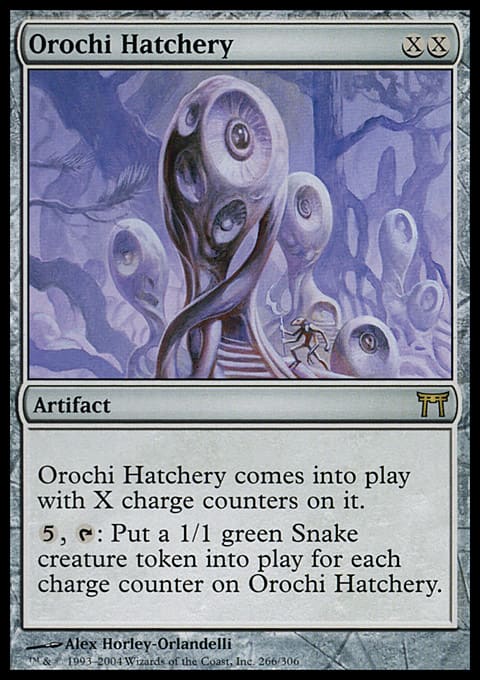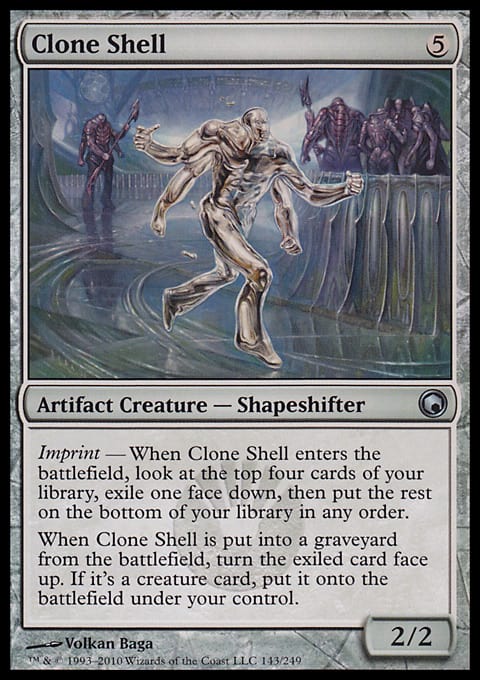A Mr. Adam Styborski discussed dismantling Commander decks recently:
I find this even harder with sixty-card decks. Often, I've bought play sets of very particular cards to work with an idea, and so retiring decks makes me feel that I wasted the purchases. But I've had years of fun with the cards, and they’re usually junk rares anyway. If I can gain more value by taking that deck apart to clear space for a new one, I should let nostalgia go and get brewing. Scavenging some decks for Commander parts has opened up some sixty-card space that I'm excited to jump into.
In this article, I'll refurbish older decks, and next time, I'll build some new ones. I didn't realize how much my casual brewing had stalled for feeling full-up on decks; with room for new things, the fever's back.
Recharging a Charge Counter Deck
Two Junes ago, I built a Celestial Convergence deck around Chisei, Heart of Oceans, Woolly Razorback, and the War of 1812. The war to get Chisei and the Razorback in fun decks continues with this charge counter deck:
"The Counter Store"
- Creatures (16)
- 2 Chronomaton
- 2 Aven Mimeomancer
- 4 Chisei, Heart of Oceans
- 4 Woolly Razorback
- 4 Vedalken Infuser
- Noncreatures (44)
- 4 Unstable Mutation
- 4 Orochi Hatchery
- 3 Trigon of Mending
- 2 Surge Node
- 2 Power Conduit
- 2 Conversion Chamber
- 2 Chimeric Egg
- 2 Angelheart Vial
- 23 Basic Land
There's a lot of fun stuff going on this deck: playing Orochi Hatchery for 0 and using Surge Node to make it ridiculous, removing a -1/-1 counter with Power Conduit to put a +1/+1 counter on the same creature, beating face with Chimeric Egg, and similar quirks. But I've had the deck for most of a year, and I've never won with it. I have fun losing with it, but I wouldn't mind the deck working.
So, I bought some Sun Droplets, Lux Cannons, and more Power Conduits to streamline the deck and give it desperately-needed removal. Sun Droplet is better life-gain than Trigon of Mending or Angelheart Vial, and it still gives plenteous counters should Chisei or Power Conduit wish to use them. (Fortuitously, Sun Droplet's counter-removal trigger is optional, so you can choose not to gain life should you want to move the counter instead.)
But while it's easy to know what to include, it was tougher to know what to remove. I had avoided the proliferate route because I had done it before (with Necrogen Censer and Bloodchief Ascension, natch) and had been annoyed by decks that took five minutes a turn proliferating. However, Thrummingbird is better at the Aven Mimeomancer and Chronomaton role: Come out early, make counters, and provide a reasonable clock with Unstable Mutation. The fact that it proliferates doesn't mean it's the Metaclock liability some proliferate cards are. (That's a good lesson for me: Not every card in an annoying mechanic is annoying.)
With all those changes, behold!
"The Counter Store: Grand Re-Opening"
- Creatures (16)
- 4 Thrummingbird
- 4 Chisei, Heart of Oceans
- 4 Woolly Razorback
- 4 Vedalken Infuser
- Noncreatures (44)
- 4 Unstable Mutation
- 4 Orochi Hatchery
- 4 Sun Droplet
- 4 Power Conduit
- 3 Lux Cannon
- 2 Surge Node
- 23 Basic Land
I don't know how much better this version is than the previous one, but it's streamlined, has a lower curve and reusable removal, and can turn bad counters into good ones easier.
The deck is still built around Chisei and Woolly Razorback; thawing out the 7/7 isn't too hard with Chisei, Power Conduit, and the occasional block. Unstable Mutation and Sun Droplet provide the bulk of the counters to move, while Orochi Hatchery and Lux Cannon are the intended beneficiaries. It is often correct to play Orochi Hatchery as a 0-drop because you'll put counters on it soon enough. Dropping Orochi Hatchery and Surge Node on turn one lets the people know where the party is. Critically, Orochi Hatchery's ability is now at the top of the curve alone rather than fighting other effects.
I liked the previous version, but it was way too clunky. Changing thirteen cards makes me super-excited (super-charged?) to play this deck.
Making a Flash Deck Flashier
This deck has been one of my best decks, but it's grown stale, and I haven't given it a good update in years. As you'll see, Theros promises new life to the deck, which is why I'm excited to reconfigure it.
The previous version:
"It's All About Me-quinox"
- Creatures (30)
- 3 Joraga Treespeaker
- 3 Wall of Omens
- 4 Apex Hawks
- 4 Clone Shell
- 4 Copperhoof Vorrac
- 2 Phytohydra
- 4 Sunblast Angel
- 3 Nullstone Gargoyle
- 3 Kalonian Behemoth
- Noncreatures (30)
- 4 Vernal Equinox
- 2 Scout's Warning
- 24 Basic Land
This deck tries to answer one of those shoot-the-breeze questions: What are the best creatures to play at instant speed? Vernal Equinox giving creature and enchantment spells flash may look like a strictly worse Vedalken Orrery, but it does several things the Orrery doesn't. First, it can change how everybody plays. In my experience, few players leverage the Equinox as they should, but the Equinox has the potential to change much more of the game than the Orrery does. Second, giving everybody flash means that, for as many opponents as are leery of it, there will be some opponents you turn into friends with it. The Equinox is sometimes a target, but it rarely makes you a target; it just becomes lumped with Howling Mine effects as the group hug some don't want. Third, a play set of the Equinox costs $2 instead of the Orrery's $25, freeing up money for some really good curry—or anything else, I suppose.
Giving flash to creatures and enchantments made me interested when Theros provided a load of enchantment creatures. Even as giving creature spells flash would get the particular job done, mentioning both was a reminder that bestow creatures could shine in this deck. Boon Satyr is a pest in Standard for messing up combat, damage-based removal, and board sweepers, and the prospect of wreaking similar havoc with other bestowers is delicious—like a really good curry.
Putting those considerations together, here's the new list:
"It's Still About Me-quinox"
- Creatures (32)
- 4 Mikaeus, the Lunarch
- 2 Viridian Emissary
- 3 Wall of Omens
- 4 Celestial Crusader
- 4 Clone Shell
- 3 Celestial Archon
- 4 Copperhoof Vorrac
- 4 Sunblast Angel
- 4 Graven Dominator
- Noncreatures (28)
- 4 Vernal Equinox
- 20 Basic Land
- 4 Selesnya Guildgate
This meatball is much spicier. The deck still centers around Vernal Equinox, Clone Shell, Sunblast Angel, and Copperhoof Vorrac. Giving flash to Sunblast Angel makes it even more ridiculous than Restoration Angel; there's no problem giving flash to opponents' creatures if you have the trump for all of them. Clone Shell can turn into a midcombat Sunblast Angel. When opponents don't know what's in your deck, Clone Shell is a giant question mark on the field; when opponents know that Sunblast Angel is in your deck, Clone Shell is a giant exclamation point. Copperhoof Vorrac can flash in as a humongous creature, but its more important role is to encourage opponents to tap out so Sunblast Angel punishes them.
The support creatures were decent—Kalonian Behemoth was immovable and therefore excellent with flash, and Nullstone Gargoyle tended to make creatures the only effective flash spells—but costing 7 and 9 mana was a liability, even with Joraga Treespeaker as elite acceleration. In the place of those, Phytohydra (it was not the gotcha card I anticipated), mana-sink Apex Hawks, and Equinox backup Scout's Warning is a slightly better curve and more cohesive strategy.
The cards taken out combine to cost 75 mana; the new ones cost 63, and while there are still about as many creatures costing 5 or more mana, they don't cost more than 6. Viridian Emissary takes the Joraga Treespeaker slot; it's just enough of a rattlesnake that with Wall of Omens, it's a legitimate early defense. Mikaeus is the new Apex Hawks (not every day I am able to type that) and a curve-filler with upside, and in this deck, he should be cast early if there are no other plays.
The primary changes center around Graven Dominator as a finicky Sunblast Angel. Flashing in a Graven Dominator after blockers have been declared will kill most creatures in combat, like a 4/4 Fight to the Death; if creatures are attacking you, it will prevent a load of damage and kill one of the best attackers. It too can be nasty under a Clone Shell; at the very least, Clone Shell's dealt 2 damage to a thing that's about to be a 1/1, and if Viridian Emissary's blocked, Graven Dominator upgrades its impact.
Of course, in the abstract, Graven Dominator will kill your big creatures as well. That's why the other new creatures break the symmetry. Celestial Crusader will boost most of your team, Celestial Archon's first strike matters even when everything's a 1/1, Mikaeus can pump the team (and as a 0/0, Graven Dominator's ability pumps it), and Copperhoof Vorrac is scary regardless of its base toughness. I don't know how useful Graven Dominator is at sorcery speed, but with enough Celestial Crusader and Mikaeus pumps, it should allow for an unexpected alpha strike. I don't know, but I'm excited to find out.
Conclusion
Whether a deck has been underperforming or good, whether new cards have come out for it or not, and whether you spend a couple dollars or work entirely with your collection, what might look like changes at the margins—a play set or two—can make a deck far more interesting to play. Try some stuff you've never found a home for; the more you use your entire collection, the better you'll feel about owning it. Part of Magic's appeal is interaction and discovery between your creations and others' creations, but there's discovery between your creations and you as well, so remember that, and you'll have far more fun.


























